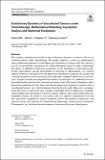Files in this item
Evolutionary dynamics in vascularised tumours under chemotherapy : mathematical modelling, asymptotic analysis and numerical simulations
Item metadata
| dc.contributor.author | Villa, Chiara | |
| dc.contributor.author | Chaplain, Mark Andrew Joseph | |
| dc.contributor.author | Lorenzi, Tommaso | |
| dc.date.accessioned | 2020-10-12T10:30:01Z | |
| dc.date.available | 2020-10-12T10:30:01Z | |
| dc.date.issued | 2020-10-06 | |
| dc.identifier | 269967305 | |
| dc.identifier | 72279180-451c-442a-9b0e-7de674c2b9b8 | |
| dc.identifier | 000576130300001 | |
| dc.identifier | 85092095732 | |
| dc.identifier.citation | Villa , C , Chaplain , M A J & Lorenzi , T 2020 , ' Evolutionary dynamics in vascularised tumours under chemotherapy : mathematical modelling, asymptotic analysis and numerical simulations ' , Vietnam Journal of Mathematics , vol. First Online . https://doi.org/10.1007/s10013-020-00445-9 | en |
| dc.identifier.issn | 0866-7179 | |
| dc.identifier.other | ORCID: /0000-0001-5727-2160/work/82179661 | |
| dc.identifier.uri | https://hdl.handle.net/10023/20767 | |
| dc.description.abstract | We consider a mathematical model for the evolutionary dynamics of tumour cells in vascularised tumours under chemotherapy. The model comprises a system of coupled partial integro-differential equations for the phenotypic distribution of tumour cells, the concentration of oxygen and the concentration of a chemotherapeutic agent. In order to disentangle the impact of different evolutionary parameters on the emergence of intra-tumour phenotypic heterogeneity and the development of resistance to chemotherapy, we construct explicit solutions to the equation for the phenotypic distribution of tumour cells and provide a detailed quantitative characterisation of the long-time asymptotic behaviour of such solutions. Analytical results are integrated with numerical simulations of a calibrated version of the model based on biologically consistent parameter values. The results obtained provide a theoretical explanation for the observation that the phenotypic properties of tumour cells in vascularised tumours vary with the distance from the blood vessels. Moreover, we demonstrate that lower oxygen levels may correlate with higher levels of phenotypic variability, which suggests that the presence of hypoxic regions supports intra-tumour phenotypic heterogeneity. Finally, the results of our analysis put on a rigorous mathematical basis the idea, previously suggested by formal asymptotic results and numerical simulations, that hypoxia favours the selection for chemoresistant phenotypic variants prior to treatment. Consequently, this facilitates the development of resistance following chemotherapy. | |
| dc.format.extent | 1942822 | |
| dc.language.iso | eng | |
| dc.relation.ispartof | Vietnam Journal of Mathematics | en |
| dc.subject | Vascularised tumours | en |
| dc.subject | Evolutionary dynamics | en |
| dc.subject | Intra-tumour heterogeneity | en |
| dc.subject | Resistance to chemotherapy | en |
| dc.subject | Mathematical oncology | en |
| dc.subject | Non-local partial differential equations | en |
| dc.subject | QA Mathematics | en |
| dc.subject | RC0254 Neoplasms. Tumors. Oncology (including Cancer) | en |
| dc.subject | T-NDAS | en |
| dc.subject | SDG 3 - Good Health and Well-being | en |
| dc.subject.lcc | QA | en |
| dc.subject.lcc | RC0254 | en |
| dc.title | Evolutionary dynamics in vascularised tumours under chemotherapy : mathematical modelling, asymptotic analysis and numerical simulations | en |
| dc.type | Journal article | en |
| dc.contributor.institution | University of St Andrews. School of Mathematics and Statistics | en |
| dc.contributor.institution | University of St Andrews. Applied Mathematics | en |
| dc.identifier.doi | 10.1007/s10013-020-00445-9 | |
| dc.description.status | Peer reviewed | en |
| dc.date.embargoedUntil | 2020-10-06 |
This item appears in the following Collection(s)
Items in the St Andrews Research Repository are protected by copyright, with all rights reserved, unless otherwise indicated.

